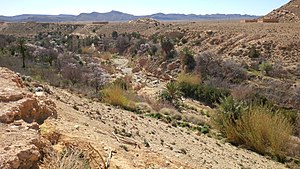Deserts and xeric shrublands


Deserts and xeric shrublandsare abiomedefined by theWorld Wide Fund for Nature.[1]Desertsand xeric (ancient Greek xērós, “dry" )shrublandsform the largest terrestrial biome, covering 19% ofEarth's land surface area.[2]Ecoregions in this habitat type vary greatly in the amount of annual rainfall they receive, usually less than 250 millimetres (10 in) annually except in the margins. Generally evaporation exceeds rainfall in these ecoregions. Temperature variability is also diverse in these lands. Many deserts, such as theSahara,are hot year-round, but others, such as East Asia'sGobi,become quite cold during the winter.[1]
Temperature extremes are a characteristic of most deserts. High daytime temperatures give way to cold nights because there is no insulation provided byhumidityand cloud cover. The diversity of climatic conditions, though quite harsh, supports a rich array of habitats. Many of these habitats areephemeralin nature, reflecting the paucity and seasonality of available water.[1]Woody-stemmed shrubs and plants characterize vegetation in these regions. Above all, these plants have evolved to minimize water loss. Animal biodiversity is equally well adapted and quite diverse.[1]
Degradation[edit]
Desertification[edit]

The conversion of productivedrylandsto desert conditions, known asdesertification,can occur from a variety of causes. One is human intervention, including intensive agricultural tillage orovergrazing[4]in areas that cannot support such exploitation. Climatic shifts such asglobal warmingor theMilankovitch cycle(which drivesglacialsandinterglacials) also affect the pattern of deserts on Earth.
Woody plant encroachment[edit]
Xeric shrublands can experience woody plant encroachment, which is the thickening of bushes and shrubs at the expense of grasses.[5]This process is often caused by unsustainable land management practices, such as overgrazing and fire suppression, but can also be a consequence of climate change. As a result, coreecosystem servicesof the shrublands are affected, including its biodiversity, productivity and groundwater recharge.[6]Woody plant encroachment can be an expression of land degradation.[7]
Ecoregions[edit]
The World Wide Fund for Nature highlights a number of desertecoregionsthat have a high degree ofbiodiversityandendemism:[1]
- TheNama Karooof Namibia has the world's richest desert fauna.[8]
- TheChihuahuan desertandCentral Mexican matorralare the richest deserts in theNeotropics.[9]
- TheCarnarvon xeric shrublandsof Australia are a regional center for endemism.[1]
- TheSonoranandBaja desertsof Mexico are unusual desert communities dominated by giantcolumnar cacti.[1]
- Madagascar spiny forests
- Atacama Desert
See also[edit]
- Hydric soil– soil type
- Mesic– Habitat with a moderate supply of moisture
- Rain shadow– Leeward side of a mountain range
- Sagebrush steppe– Grassland ecosystem
- Shrub-steppe– Ecoregion characterized by semi-arid grassland and/or shrubland plains
- Temperate grasslands, savannas, and shrublands– Terrestrial biome
- Xeriscaping— gardening or landscaping in xeric environments
- Xerocoles— animals adapted to xeric environments
- Xerophytes— plants adapted to xeric environments
References[edit]
- ^abcdefg
 This article incorporates text available under theCC BY-SA 3.0license.World Wide Fund for Nature."Deserts and Xeric Shrubland Ecoregions".Archivedfrom the original on 2012-04-25.Retrieved2019-05-29.
This article incorporates text available under theCC BY-SA 3.0license.World Wide Fund for Nature."Deserts and Xeric Shrubland Ecoregions".Archivedfrom the original on 2012-04-25.Retrieved2019-05-29.
- ^Lockwood, M.Managing Protected Areas: A Global Guide.p. 199.
- ^"Nama Karoo".WWF.Retrieved2018-12-19.
- ^Hogan, C. Michael (2009)."Overgrazing".In Draggan, Sidney; Cleveland, Cutler J. (eds.).Encyclopedia of Earth.Washington, D.C.: National council for Science and the Environment.
- ^Eldridge, David J.; Bowker, Matthew A.; Maestre, Fernando T.; Roger, Erin; Reynolds, James F.; Whitford, Walter G. (July 2011)."Impacts of shrub encroachment on ecosystem structure and functioning: towards a global synthesis: Synthesizing shrub encroachment effects".Ecology Letters.14(7): 709–722.doi:10.1111/j.1461-0248.2011.01630.x.PMC3563963.PMID21592276.
- ^Archer, Steven R.; Andersen, Erik M.; Predick, Katharine I.; Schwinning, Susanne; Steidl, Robert J.; Woods, Steven R. (2017), Briske, David D. (ed.), "Woody Plant Encroachment: Causes and Consequences",Rangeland Systems,Springer Series on Environmental Management, Cham: Springer International Publishing, pp. 25–84,doi:10.1007/978-3-319-46709-2_2,ISBN978-3-319-46707-8,S2CID133015720
- ^Schlesinger, William H.; Reynolds, James F.; Cunningham, Gary L.; Huenneke, Laura F.; Jarrell, Wesley M.; Virginia, Ross A.; Whitford, Walter G. (1990-03-02)."Biological Feedbacks in Global Desertification".Science.247(4946): 1043–1048.Bibcode:1990Sci...247.1043S.doi:10.1126/science.247.4946.1043.ISSN0036-8075.PMID17800060.S2CID33033125.
- ^Cowling, RM; Hilton-Taylor, C (1994). "Patterns of plant diversity and endemism in southern Africa: An overview". In Huntley, BJ (ed.).Botanical diversity in southern Africa.Pretoria, South Africa: National Botanical Institute. pp. 31–52.
- ^Hernandez, HM; Barcenas, RT (1995). "Endangered cacti in the Chihuahuan Desert: I. Distribution patterns".Conservation Biology.9(5): 1176–1188.doi:10.1046/j.1523-1739.1995.9051169.x-i1.PMID34261239.
External links[edit]
- Index to Deserts & Xeric Shrublands at bioimages.vanderbilt.edu
- Xeric WorldOnline community focused on the study of xeric plant species
- Desert Plants: List, Names and Adaptations
